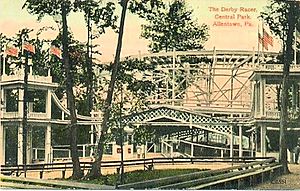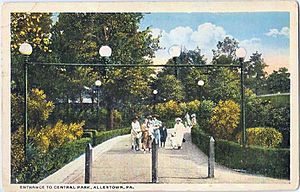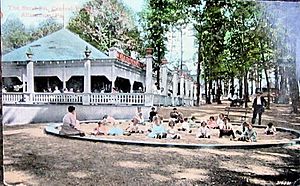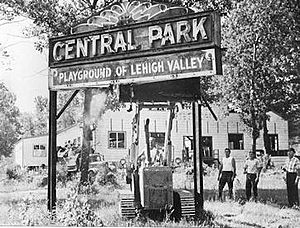Central Park (Allentown, Pennsylvania) facts for kids
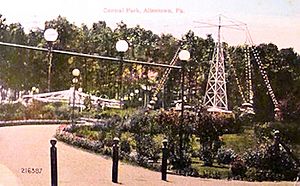
1914 postcard of Central Park
|
|
| Location | Allentown, Pennsylvania, U.S. |
|---|---|
| Coordinates | 40°37′20″N 075°25′15″W / 40.62222°N 75.42083°W |
| Status | Closed |
| Opened | 1893 |
| Closed | 1951 |
| Area | 40 acres (0.16 km2) |
| Attractions | |
| Total | 25 |
| Roller coasters | 1 |
| Water rides | 1 |
Central Park was a popular amusement park located in the Rittersville area of Allentown, Pennsylvania. It offered many exciting rides and shows for people of all ages. The park officially closed its doors in 1951.
Contents
The Park's Beginnings
Central Park started way back in 1868. A man named J. Frank Reichart created a race track for horses. This track was open from May to August. In 1872, a group called the Rittersville Park Association took over. They made the park bigger, expanding it to 16 acres. It was then known as Manhattan Park.
Later, the Allentown & Bethlehem Rapid Traction Company bought the land. They renamed it The Greater Central Park. This new park even had a collection of animals, including elephants!
A "Trolley Car Park"
Central Park was a special kind of park called a "trolley car park." Trolley companies wanted people to use their trolleys more often. They were busy during the week but not on weekends. So, they built amusement parks like Central Park. This encouraged people to ride the trolleys out of town. It also helped sell land near the trolley lines.
The park officially opened on July 2, 1893. It was first called Rittersville Park. It had 40 acres of shady paths and benches. The park was built in a wooded area. It featured picnic spots, walking trails, and a few fun amusements. There were also theaters and food stands.
The first rides included a carousel and a toboggan chute. There was also a ride called the "Razzle-Dazzle." Around 1898, the animal collection closed. The owner of the Manhattan Hotel bought two monkeys. One of them accidentally set the hotel on fire! The hotel was rebuilt that same year. The new Manhattan Hotel became a stylish place. People came from far away to visit the park. It had one of the biggest outdoor theaters in Pennsylvania.
The Golden Age of Central Park
By the early 1900s, Central Park grew very popular. Its best years were between 1906 and 1920. In 1906, the trolley company built a large theater. It could hold 1,600 people. Famous musicians came to perform there. One of the biggest stars was John Philip Sousa's band. Soon, people were dancing new dances like the turkey-trot.
Plays became very popular too. By 1912, the theater was made even bigger. It could then seat 2,500 people. Two very popular plays were "Only 45 Minutes From Broadway" and "The Mayor of Tokio."
Exciting Rides and Fun for Families
Central Park had many thrilling rides. The Racing Coaster, also known as the Derby Racer, was a big hit. The park claimed it was the best ride of its kind in the eastern United States. Other rides included The Frolic and the Circle Swing. There was also "Shoot the Chute," a water ride. It ended with a big drop into a lake, much like rides at Coney Island.
The park was also a great place for family gatherings. Businesses, clubs, and churches held picnics there. Children loved the large sandbox. Older kids enjoyed the swings and other rides. The park even hosted fun events like baby parades.
Challenges and Closure
In 1899, a new trolley line opened. It went from Allentown to Kutztown. This line added a stop at Dorney Park. Dorney Park was Central Park's main competitor. But Central Park continued to do well for many years.
In 1922, the old Manhattan Hotel was torn down. A new building, the Manhattan Auditorium, was built in its place. This auditorium was used for many events. These included dance marathons, auto shows, and roller skating.
By the late 1920s, cars became very common. This was a big challenge for Central Park. It relied on trolley riders. Dorney Park, however, had lots of space for cars. This gave Dorney Park an advantage.
Fires and the End of an Era
Sadly, Central Park faced many fires over its last twenty years. The first big fire happened on August 16, 1932. It damaged a funhouse, the Mystic Castle, and the outdoor theater. Another fire in 1935 destroyed the Cyclone Coaster. Fires in 1940 and 1941 burned the popular Dodge'em ride and the dance hall. In 1944, the bowling alley and billiard parlor also burned.
On Christmas Day, 1950, a fire destroyed the beloved carousel. It also burned the prized Derby Racer. Then, on August 2, 1951, another fire broke out. This time, it was the second outdoor theater. This theater had replaced the one that burned in 1932.
After this last fire, Central Park officially closed in December 1951. The land remained empty for over ten years. In the early 1960s, the land was sold for new buildings. The last parts of Central Park were torn down in 1964. Today, only a few old concrete foundations remain. They are hidden among the trees and new homes built on the site.
Images for kids


